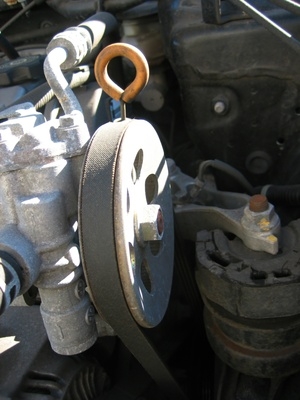
Drive belts supply reliable power transmission in a vast array of applications including industrial machines, power tools, appliances and transportation, to name just a few. Belts tend to be better for high speed, moderate torque applications, as opposed to drive chains, which are better for higher torques and lower speeds. They are also better than gears wherever the rotational driving force must be transmitted over a long distance. Calculating the effective tension Te of drive belts is a methodical process with much industry data available to help the first-timer.
Define the belt drive tension application. In this example, a motor develops 2-horsepower turning at 1800 revolutions per minute (rpm) as it drives a pump through a timing belt drive, with a static tension of 4 lb. to remove slack. If the driven pulley on the pump is 12 inches in diameter compared to the motor's 3-inch diameter pulley, you can calculate the effective tension Te, as well as the tight and slack side tensions T1 and T2 as the system operates.

Calculate the pump speed and driven torque requirements. Since the motor is developing 2 horsepower at 1800 revolutions per minute, the motor equation Torque = hp X 5250/rpm applies to determine torque supplied by the motor: T = 2 X 5250/1800 = 5.833 ft-lb. The pitch diameter relationship between the pulleys determines that the speed of the pump is 3 inches/12 inches X 1800 rpm = 450 rpm. Inversely, the torque would be 12/3 X 5.833 ft-lb or 23.33 ft-lb.

Determine the applicable timing belt tension formulas to determine the tension forces. The driving (motor) torque is equation is M1 = Te X d1/2 where M1 is motor torque, and d1 is driving pulley diameter. Re-arranging to solve for Te, Te = 2 X M1/d1. Substituting stated values, Te = 2 X 5.833 / 3 inches = 3.889 lb of tension.
Calculate the tight-side and slack side tensions T1 and T2 respectively while operating. When the system is off, T1 = T2 = static tension force keeping the belt tight. While operating, Te = T1-T2. Because the tight side of the belt supplies all of the force to turn the pump, T1-T2 = 3.88 lb. Adding this force to the static force on T1 determines that T1 tension = 4 lb. static tension + 3.88 lb. = 7.88 lb. The only tensional force on the slack side of the belt is 4-lb. static tension + zero driving tension = 4 lb.